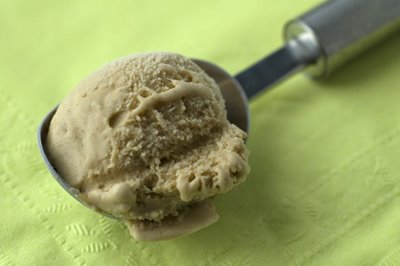
Scotch pancakes are one of many Scottish cakes cooked on a flat bakestone or girdle (griddle to the English). The Scottish poet Robert Burns described his native land as a 'Land o' Cakes'. He may have meant the oatcake in particular, but 'cake' also meant more generally any form of bread (leavened or unleavened), or cereal-based baked foodstuff. A pancake was a 'cake' cooked on a heated flat-surface; historically a bakestone, hearthstone or girdle, and eventually a pan. Scotch pancakes are also known as 'drop' or 'dropped scones', because soft dollops of mixture are dropped onto the cooking surface. According to Laura Mason, the Scottish are the originators of the scone (a subset of the cake genus), and the 'Scotch pancake' is one of its many forms. I look forward to exploring other members of the Scottish scone family shortly...
The method of cooking on a heated surface is a very ancient one. If you only have a wood or peat fuelled fire for your cooking, it is a simple matter to bury a stone in the embers, or to prop a metal pan over the flames in order to heat the cooking surface. The Welsh have similar girdle-cooked foods of long heritage - such as crempogs (ffroes) and Welsh cakes (The Oxford Companion to Food mentions a theory that the Scottish miners who travelled south to work in the Welsh coal districts of Glamorganshire, were responsible for bringing the girdle pancake recipe with them.). Northern England shared the oatcake with the Scottish Highlands, as both areas were well suited to the cultivation of oats, although different regions prepared the oatcakes in slightly different way.
The 'girdle' used by the Scots for their cooking, is a round, cast-iron flat plate, with a semi-circular handle. The town of Culross in Fife, was granted a royal charter for their manufacture back in 1599 - this gave Culross a monopoly on the production of girdles for many years. The National Trust for Scotland has been working to preserve the town of Culross since the 1930s, so by the 20th century the success of Culross girdles had diminished somewhat. I have not been to the town, but it looks a handsome place.
Scotch Pancakes (recipe from this book)
120g self-raising flour
small pinch salt
30g caster sugar
1 egg
1/4 pint milk
1. First grease your girdle (I love that instruction) - use a oil as butter will burn, and then put on the hob to heat.
2. Sift the flour into a bowl and add the pinch of salt, and then tip in the sugar.
3. Crack the egg into the milk (best not to try doing this into the bottle), and whisk.
4. Pour the egg and milk liquid into the dry ingredients, and mix to form a smooth batter.
5. Test that the girdle is hot enough by putting a teaspoonsworth of batter onto it. You should have a fairy-size pancake cooked for you in less than a minute.
6. For the main-event pancakes, use a tablespoon to drop the batter onto the girdle. I used the back of the spoon to form the dollops into more aesthetic rounds.
7. Keep a beady eye on the batter. When the surface has become covered in bubbles get ready to flip them over using a palette knife (please ignore the scratchy metal one I am using).

Don't worry if the underside isn't as coloured as you would like it to be, you can always turn the pancake over for an extra girdling.

8. When cooked remove the pancakes from the girdle, and wrap in clean tea towel to keep moist.
The jury is out on whether to eat these hot from the girdle, or leave them to cool. Either way I think that they should be eaten on the day of cooking. This recipe makes about 18 pancakes, so a good quantity for Sunday night tea for two. Consume with butter, or butter and jam.






